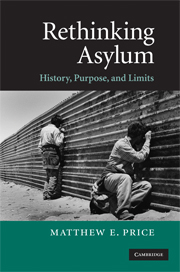Book contents
- Frontmatter
- Contents
- Acknowledgments
- Introduction
- Chapter 1 Recovering Asylum's Political Roots
- Chapter 2 Promoting Political Values through Asylum
- Chapter 3 What is “Persecution”?
- Chapter 4 Persecution by Private Parties
- Chapter 5 Asylum, Temporary Protection, and the Refugee Policy Toolkit
- Chapter 6 Restrictions on Access to Asylum
- Conclusion
- Bibliography
- Index
Chapter 3 - What is “Persecution”?
Published online by Cambridge University Press: 26 January 2010
- Frontmatter
- Contents
- Acknowledgments
- Introduction
- Chapter 1 Recovering Asylum's Political Roots
- Chapter 2 Promoting Political Values through Asylum
- Chapter 3 What is “Persecution”?
- Chapter 4 Persecution by Private Parties
- Chapter 5 Asylum, Temporary Protection, and the Refugee Policy Toolkit
- Chapter 6 Restrictions on Access to Asylum
- Conclusion
- Bibliography
- Index
Summary
The preceding chapters have articulated a political approach to asylum, one that explains why asylum should be reserved for persecuted people. Asylum provides not only protection to the refugee, but also chastises the persecutory state for its misconduct. But to precisely which kinds of harm does the label “persecution” apply? The question is a difficult one. Certain kinds of harm obviously qualify: for example, the murder or torture of political dissidents or ethnic or religious minorities constitute the classic cases of persecution. But beyond this core, which harms does the concept of “persecution” encompass? The UNHCR Handbook, meant to provide interpretive guidance to courts and administrative agencies, begins its discussion of persecution with a striking disclaimer: “There is no universally accepted definition of ‘persecution,’ and various attempts to formulate such a definition have met with little success.” Guy Goodwin-Gill, a prominent commentator, concurs that the definition of persecution has “no coherent or consistent jurisprudence.” American law, in particular, is in disarray. The asylum statute leaves “persecution” undefined, and the agency charged with issuing regulations – now the Department of Homeland Security – has offered little regulatory guidance. The federal courts of appeals, meanwhile, have employed a number of definitions which appear similar on their face but, in fact, vary in subtle ways that can have important implications.
The growing acceptance of a humanitarian conception of asylum partly explains the confusion over persecution's meaning.
- Type
- Chapter
- Information
- Rethinking AsylumHistory, Purpose, and Limits, pp. 103 - 145Publisher: Cambridge University PressPrint publication year: 2009



